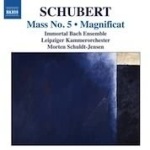If you’re a fan of Schubert’s sacred choral music, this Naxos series, which includes all six Masses and other church works, promises consistently fine performances as good or better than the catalog competition, very well recorded in the complementary acoustics of a Leipzig church. A significant advantage is the presence of the same performing forces throughout the series–and they are solid, well-practiced, and very effective interpreters of this music, which, especially in the earlier works, isn’t always the most dynamic or inventive or inspired (for a review of Masses Nos. 1 & 3, type Q13161 in Search Reviews). However, this Mass No. 5 in A-flat major, completed in 1822 when the composer was what for him would turn out to be the “ripe old age” of 25 (he revised the Mass four years later)–is a work decidedly more substantive and refined, particularly regarding the more skillful treatment of the orchestra and more proficient handling of thematic ideas in the choral and solo parts.
The opening is a nifty little imitative sequence–first a choir of winds, then one of strings, followed by the choral sopranos and altos, then tenors and basses, gradually bringing everyone together. There are other memorable moments–the powerful fugal conclusion to the Gloria, the dramatic opening section of the Credo, complete with brass interjections, the strange “horn-call” recurring theme in the Sanctus. Perhaps most memorable is the sheer number and variety of ideas Schubert has crammed into this 40-minute work, which may not add up to the most cohesive Mass ever written, but it’s hard to fault the composer for the attractiveness of those ideas or for his command of orchestral and choral resources.
Schubert’s C major Magnificat is not a complete setting of this beloved text–it uses only the beginning “Magnificat anima mea Dominum” and “Deposuit potentes de sede” verses, concluding with the “Gloria Patri”. Its relatively short timing (not quite nine minutes) and big scoring (four soloists, choir, pairs of oboes, bassoons, trumpets, and drums, plus strings and organ) probably ensures its virtual neglect by concert programmers, but there’s some fine music here, especially the “Deposuit…” section that features lovely Mozartean writing for the ensemble of soloists. As mentioned, Schubert fans should not hesitate, and if you’re a listener looking for a way in to the composer’s church music, this is an excellent place to start. Recommended. [1/28/2011]
































